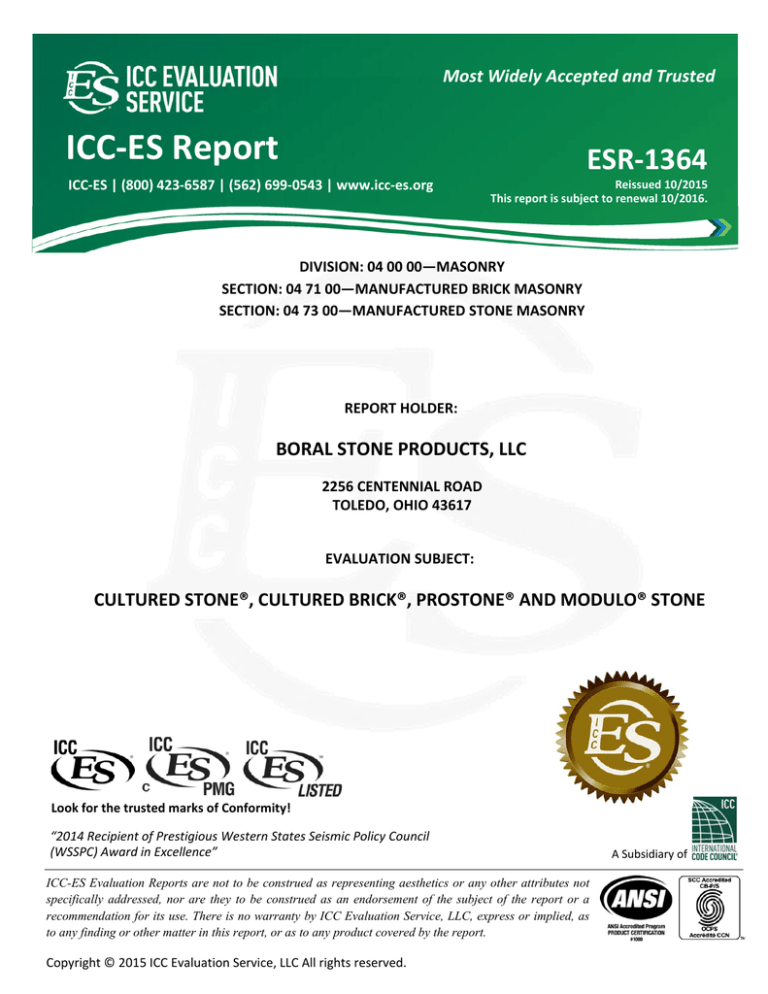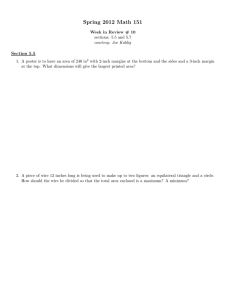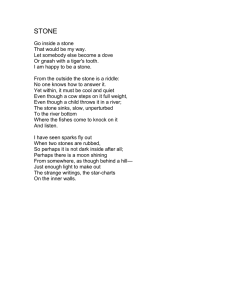
Most Widely Accepted and Trusted 0 ICC‐ES Report ESR‐1364
ICC‐ES | (800) 423‐6587 | (562) 699‐0543 | www.icc‐es.org
000 Reissued 10/2015
This report is subject to renewal 10/2016.
DIVISION: 04 00 00—MASONRY SECTION: 04 71 00—MANUFACTURED BRICK MASONRY SECTION: 04 73 00—MANUFACTURED STONE MASONRY REPORT HOLDER: BORAL STONE PRODUCTS, LLC 2256 CENTENNIAL ROAD TOLEDO, OHIO 43617 EVALUATION SUBJECT: CULTURED STONE®, CULTURED BRICK®, PROSTONE® AND MODULO® STONE Look for the trusted marks of Conformity! “2014 Recipient of Prestigious Western States Seismic Policy Council (WSSPC) Award in Excellence” ICC-ES Evaluation Reports are not to be construed as representing aesthetics or any other attributes not
specifically addressed, nor are they to be construed as an endorsement of the subject of the report or a
recommendation for its use. There is no warranty by ICC Evaluation Service, LLC, express or implied, as
to any finding or other matter in this report, or as to any product covered by the report.
Copyright © 2015 ICC Evaluation Service, LLC All rights reserved.
A Subsidiary of ICC-ES Evaluation Report
ESR-1364
Reissued October 2015
This report is subject to renewal October 2016.
www.icc-es.org | (800) 423-6587 | (562) 699-0543
DIVISION: 04 00 00—MASONRY
Section: 04 71 00—Manufactured Brick Masonry
Section: 04 73 00—Manufactured Stone Masonry
cement, aggregate, water, admixtures and mineral oxide
colors. The average saturated veneer weight does not
2
exceed 15 pounds per square foot (73.2 kg/m ). See Table
1 for recognized patterns.
REPORT HOLDER:
The stone veneer has a Class A (Class I) finish rating in
accordance with IBC Section 803.1.1, and complies with
the flame-spread and smoke-development requirements of
IRC Section R302.9. Additionally, the stone veneer has an
R-value of 0.355 when tested at a thickness of 1.0 inch
(25.4 mm) in accordance with ASTM C177.
BORAL STONE PRODUCTS, LLC
2256 CENTENNIAL ROAD
TOLEDO, OHIO 43617
(419) 318-5345
www.culturedstone.com
EVALUATION SUBJECT:
®
®
®
CULTURED STONE , CULTURED BRICK , PROSTONE
®
AND MODULO STONE
1.0 EVALUATION SCOPE
1.1 Compliance with the following codes:
®
2012 International Building Code (IBC)
2012 International Residential Code® (IRC)
Other Codes (see Section 8.0)
Properties evaluated:
Interior finish and trim classification
The attributes of the stone veneer have been verified as
conforming to the requirements of (i) 2013 CALGreen
Section A4.405.1.3 for prefinished building materials and
Section A5.406.1.2 for reduced maintenance; (ii) ICC 7002012 Section 602.1.6 for termite-resistant materials and
Sections 601.7, 11.601.7, and 12.1(A).601.7 for siteapplied finishing materials; and (iii) ICC 700-2008 Section
602.8 for termite-resistant materials and Section 601.7 for
site-applied finishing materials. Note that decisions on
compliance for those areas rest with the user of this report.
The user is advised of the project-specific provisions that
may be contingent upon meeting specific conditions, and
the verification of those conditions is outside the scope of
this report. These codes or standards often provide
supplemental information as guidance.
4.0 INSTALLATION
Thermal resistance
4.1 General:
Exterior veneer characteristics
1.2 Evaluation to the following green code(s) and/or
standards:
2013 California Green Building
(CALGreen), Title 24, Part 11
A Subsidiary of the International Code Council ®
Standards
Code
2012 and 2008 ICC 700 National Green Building
Standard™ (ICC 700-2012 and ICC 700-2008)
Attributes verified:
See Section 3.0
2.0 USES
Cultured Stone®, Cultured Brick®, ProStone® and Modulo®
Stone are used as adhered, non-load-bearing exterior
veneer or as an interior finish and trim on wood or light
gage steel stud framing, concrete or masonry walls.
3.0 DESCRIPTION
Cultured Stone®, Cultured Brick®, ProStone® and Modulo®
Stone are precast concrete products made to resemble
natural stone or brick. The stone veneer is made from
Installation of the stone veneer must comply with this
report,
the
manufacturer’s
published
installation
instructions, and the applicable code. The manufacturer’s
published installation instructions must be available at the
jobsite at all times during installation. The veneer has been
evaluated for application over backings of cement plaster,
concrete and masonry.
4.2 Preparation of Backing:
4.2.1
Cement Plaster Backings: Cement plaster
backings may be applied over plywood, OSB or gypsum
sheathing, supported by wood or steel studs; over open
wood or steel studs; over concrete walls; and over
masonry walls, when installed as described in Sections
4.2.1.1 and 4.2.1.2.
4.2.1.1 Installation
over
Studs:
For
exterior
installations, the cement plaster backing must be installed
over a water-resistive barrier complying with IBC Sections
1404.2 and 2510.6 or IRC Sections R703.2 and R703.6.3,
as applicable. Also, flashing must be installed as required
by IBC Sections 1405.4 and 1405.10.1.2 or IRC Sections
R703.8 and R703.12.2, as applicable, and weep screeds
ICC-ES Evaluation Reports are not to be construed as representing aesthetics or any other attributes not specifically addressed, nor are they to be construed
as an endorsement of the subject of the report or a recommendation for its use. There is no warranty by ICC Evaluation Service, LLC, express or implied, as
to any finding or other matter in this report, or as to any product covered by the report.
1000
Copyright © 2015 ICC Evaluation Service, LLC. All rights reserved.
Page 1 of 3
ESR-1364 | Most Widely Accepted and Trusted
must be installed at the bottom of the stone veneer. The
weep screeds must comply with, and be installed in
accordance with, IBC Section 1405.10.1.2 or IRC Section
R703.12.2, as applicable. In addition, the weep screeds
must have holes with a minimum diameter of 3/16 inch
(4.8 mm) spaced at a maximum of 33 inches (838 mm) on
center, as required by Section 6.1.6.2 of TMS 402/ACI
530/ASCE 5, which is referenced in IBC Section 1405.10.
The veneer must be installed with the clearances required
by IBC Section 1405.10.1.3 or IRC Section R703.12.1, as
applicable.
Studs must be spaced a maximum of 16 inches
(406 mm) on center. Lath must be a 2.5 lb/yd2 (1.4 kg/m2),
galvanized, self-furring diamond mesh metal lath,
2
2
conforming to ASTM C847, or a 1.4 lb/yd (0.760 kg/m )
galvanized woven wire mesh conforming to ASTM C1032.
When the cement plaster backing is installed over open
2
2
3
studs, a 3.4 lb/yd (1.8 kg/m ), /8-inch-thick-rib (9.5 mm),
paper-backed, galvanized expanded metal lath conforming
to ASTM C847 must be used. All lath must be installed
over the water-resistive barriers, following the lath
manufacturer’s installation instructions. The lath or mesh
must be fastened to each of the wall studs at 6 inches
(152 mm) on center vertically, and in accordance with the
minimum requirements of Section 7.10 of ASTM C1063, or
IRC Section R703.6.1, as applicable. For wood studs,
fasteners must be minimum 0.120-inch-shank-diameter
galvanized nails, with a 7/16-inch-diameter (11.1 mm) heads
and sufficient length to penetrate the studs a minimum of
1 inch (25.4 mm); or 16 gage galvanized staples with
minimum 3/4-inch (19.1 mm) crowns and sufficient length to
3
penetrate the studs a minimum of /4 inch (19.1 mm). For
steel studs, fasteners must be minimum 7/16-inch-headdiameter (11.1 mm), corrosion-resistant, self-drilling, selftapping, pancake head screws of sufficient length to
3
penetrate the studs a minimum of /8 inch (9.5 mm). Wood
studs must have a minimum specific gravity of 0.42. Steel
studs must be 20 gage [0.033-inch-thick (0.84 mm)],
minimum.
A scratch coat of Type N or S mortar (cement plaster)
complying with ASTM C926 must be applied over the lath
or mesh to a thickness of 1/2 to 3/4 inch (12.7 to 19.1 mm).
The mortar must be allowed to cure in accordance with
IBC Section 2512.6, prior to the application of the veneer
units.
4.2.1.2 Installation over Concrete and Masonry: The
veneer units may be applied directly to concrete or
masonry backing without lath, provided the masonry
surface is clean (see Section 4.2.3). The veneer units may
also be applied over concrete or masonry using lath and
a cement plaster backing. The lath must be a 2.5 lb/yd2
(1.4 kg/m2) diamond mesh, corrosion-resistant metal lath
complying with ASTM C847. The lath must be fastened to
the wall in accordance with Section 7.10 of ASTM C1063,
and IRC Section R703.6.1, as applicable. The fasteners
must be spaced a maximum of 6 inches (152 mm) on
center vertically and 16 inches (406 mm) on center
horizontally. The gravity load (shear) capacity and negative
wind load (pull-out) capacity of the proprietary fasteners
must be justified to the satisfaction of the code official. The
scratch coat must be applied as described in Section
4.2.1.1.
4.2.2
Concrete and Masonry Backing: Concrete and
masonry wall surfaces must be prepared in accordance
with Section 5.2 of ASTM C926, and IBC Section 2510.7,
as applicable. Alternatively, a cement plaster backing may
be installed as described in Section 4.2.1.2.
4.3 Application of Veneer Units:
Page 2 of 3
A 1/2-inch-thick to 3/4-inch-thick (12.7 to 19.1 mm), Type N
or S mortar setting bed must be applied to the masonry
backing in areas of approximately 5 to 10 square feet
(0.5 to 0.9 m2). The stone veneer must be lightly but firmly
tapped into the mortar setting bed to ensure bond while the
mortar is soft and pliable. Alternatively, the setting bed
must be applied to the back of each stone veneer unit and
the unit pressed into place. A combination of these
methods may be used. In either case the mortar setting
bed thickness and consistency must allow mortar to be
squeezed out around all edges of the veneer unit to assure
full bond. Joints must be tooled and grouted in accordance
with the manufacturer’s published installation instructions.
5.0 CONDITIONS OF USE
®
®
®
The Cultured Stone , Cultured Brick , ProStone and
®
Modulo Stone described in this report comply with, or are
suitable alternatives to what is specified in, those codes
listed in Section 1.0 of this report, subject to the following
conditions:
5.1 Installation must comply with this report, the
manufacturer’s published installation instructions and
the applicable code. In the event of a conflict between
the manufacturer’s published installation instructions
and this report, this report governs.
5.2 The precast stone veneer has been evaluated for
installation on walls with cement plaster, concrete and
masonry backings.
5.3 Expansion or control joints used to limit the effect of
differential movement of supports must be specified
by the architect, designer or stone veneer
manufacturer, in that order. Consideration must also
be given to movement caused by temperature
change, shrinkage, creep and deflection.
5.4 In jurisdictions adopting the IBC, the supporting wall
framing must be designed to support the installed
weight of the veneer system, including stone veneer,
mortar setting bed and cement plaster backing, as
applicable. At wall openings, the supporting members
1
must be designed to limit deflection to /600 of the
span of the supporting members.
5.5 In jurisdictions adopting the IRC, where the seismic
provisions of Section R301.2.2 apply, the average
weight of the wall supporting the precast stone
veneer, including the veneer system must be
determined. When this weight exceeds the applicable
limits of IRC Section R301.2.2.2.1, an engineered
design of the wall construction must be performed in
accordance with IRC Section R301.1.3.
6.0 EVIDENCE SUBMITTED
6.1 Data in accordance with the ICC-ES Acceptance
Criteria for Precast Stone Veneer (AC51), dated
February 2008 (editorially revised April 2012).
6.2 Reports of testing in accordance with ASTM C177.
6.3 Reports of testing in accordance with ASTM E84.
7.0 IDENTIFICATION
The Cultured Stone® described in this report is identified by
the initials “C.S.V.” cast into the side of each piece of
stone.
The packaging of the Cultured Stone®, Cultured Brick®,
ProStone® and Modulo® Stone products includes a stamp
bearing the manufacturer’s name, the product name, the
manufacturing plant location, the product code and the
evaluation report number (ESR-1364).
8.0 OTHER CODES
ESR-1364 | Most Widely Accepted and Trusted
8.1 Evaluation Scope:
In addition to the codes referenced in Section 1.0, the
products described in this report were evaluated for
compliance with the following codes:
2009 International Building Code® (2009 IBC)
2009 International Residential Code® (2009 IRC)
2006 International Building Code® (2006 IBC)
2006 International Residential Code® (2006 IRC)
The Cultured Stone®, Cultured Brick®, ProStone® and
Modulo® Stone products described in this report comply
with, or are suitable alternatives to what is specified in, the
codes listed above, subject to the provisions of Sections
8.2 through 8.7.
8.2 Uses:
See Section 2.0.
Page 3 of 3
8.4.2.1.1 Installation over Studs: For exterior
installations, the cement plaster backing must be installed
over a water-resistive barrier complying with 2009 and
2006 IBC Sections 1404.2 and 2510.6 or 2009 and 2006
IRC Sections R703.2 and R703.6.3, as applicable. Also,
flashing must be installed as required by 2009 IBC Section
1405.4 (2006 IBC Section 1405.3) or 2009 and 2006 IRC
Section R703.8, as applicable, and weep screeds must be
installed at the bottom of the stone veneer. The weep
screeds must comply with, and be installed in accordance
with, 2009 and 2006 IBC Section 2512.1.2 or 2009 and
2006 IRC Section R703.6.2.1, as applicable. In addition,
the weep screeds must have holes with a minimum
3
diameter of /16 inch (4.8 mm) spaced at a maximum of
33 inches (838 mm) on center, as required by Section
6.1.5.2 of TMS 402/ACI 530/ASCE 5 (Section 6.1.5.2 of
ACI 530/ASCE 5/TMS 402), which is referenced in 2009
IBC Section 1405.10 (2006 IBC Section 1405.9).
For additional requirements, see the second paragraph
of Section 4.2.1.1.
8.3 Description:
See the first paragraph of Section 3.0 and the following:
The precast veneer has a Class A finish rating in
accordance with 2009 IBC Section 8.3.1.1 (2006 IBC
Section 803.1) and complies with the flame-spread and
smoke-development requirements of 2009 IRC Section
R302.9 (2006 IRC Section R315). The stone veneer has
an R-value of 0.355 when tested in accordance with ASTM
C177 at an average thickness of 1.0 inches (25.4 mm).
8.4.2.1.2 Installation over Concrete or Masonry: See
Section 4.2.1.2.
8.4 Installation:
See Section 6.0.
8.4.1 General: See Section 4.1.
8.7 Identification:
8.4.2 Preparation of Backing:
See Section 7.0.
8.4.2.1
8.4.3 Application of Veneer Units: See Section 4.3.
8.5 Conditions of Use:
See Section 5.0.
8.6 Evidence Submitted:
Cement Plaster Backings: See Section 4.2.1.
TABLE 1—RECOGNIZED PATTERNS
PRODUCT NAME
Cultured Stone
Handmade Brick
®
Fieldstone, French Cobble, Quarry Ledgestone, River Rock, Weathered Ledgestone
®
Modulo Stone
Aged Tumbled, Alpine Pro-Fit Ledgestone, Ancient Villa, Del Mare, Carolina Ledgestone, Cast-Fit,
Cobblefield, Coral Stone, Country Ledgestone, Dressed Fieldstone, Driftstone, Drystack, European Castle
Stone, Fieldstone, Large Coral, Limestone, Old Country Fieldstone, Pro-Fit Ledgestone, River Rock,
Rockface, Southern Ledgestone, Split Face, Stream Stone, Stream Stone Skimmer, Water Wash Wall Stone,
Weather Edge Ledgestone
®
Cultured Brick
ProStone
®
PATTERNS
Aged Ledgestone, Easy Fit Savannah Ledgestone, Fieldstone, Ledgestone, River Rock, Tuscan Cobble
ICC-ES Evaluation Report
ESR-1364 CBC and CRC Supplement
Reissued October 2015
This report is subject to renewal October 2016.
www.icc-es.org | (800) 423-6587 | (562) 699-0543
A Subsidiary of the International Code Council ®
DIVISION: 04 00 00—MASONRY
Section: 04 71 00—Manufactured Brick Masonry
Section: 04 73 00—Manufactured Stone Masonry
REPORT HOLDER:
BORAL STONE PRODUCTS, LLC
2256 CENTENNIAL ROAD
TOLEDO, OHIO 43617
(419) 318-5345
www.culturedstone.com
EVALUATION SUBJECT:
®
®
®
®
CULTURED STONE , CULTURED BRICK , PROSTONE AND MODULO STONE
1.0 EVALUATION SCOPE
Compliance with the following codes:
®
2010 California Building Code (CBC)
®
2010 California Residential Code (CRC)
Properties evaluated:
Exterior veneer
Interior finish and trim classification
Thermal resistance
2.0 PURPOSE OF THIS SUPPLEMENT
This supplement is issued to indicate that the manufactured, precast stone veneer described in master report ESR-1364
complies with CBC Sections 803.1.1, 1404.4, and 2101.2.6, provided the design and installation are in accordance with the
®
International Building Code (IBC) provisions noted in the master report and the additional requirements of CBC Sections
1405.1.1, 1405.3, 1409 and 2510.7, as applicable.
The manufactured, precast stone veneer described in master report ESR-1364 complies with the flame spread and smoke
developed requirements of CRC Section R302.9 and with CRC Section R703, provided the design and installation are in
®
accordance with the International Residential Code (IRC) provisions noted in the master report and the additional
requirements of CRC Sections R301.1.3.
The manufactured, precast stone veneer has not been evaluated under CBC Chapter 7A or CRC Section R327, for use in
the exterior design and construction of new buildings located in a Fire Hazard Zone within a State Responsibility Area or any
Wildland–Urban Interface Fire Area.
The product recognized in this supplement has not been evaluated for compliance with the International Wildland–Urban
®
Interface Code .
This supplement expires concurrently with the master report reissued October 2015.
ICC-ES Evaluation Reports are not to be construed as representing aesthetics or any other attributes not specifically addressed, nor are they to be construed
as an endorsement of the subject of the report or a recommendation for its use. There is no warranty by ICC Evaluation Service, LLC, express or implied, as
to any finding or other matter in this report, or as to any product covered by the report.
1000
Copyright © 2015 ICC Evaluation Service, LLC. All rights reserved.
Page 1 of 1



